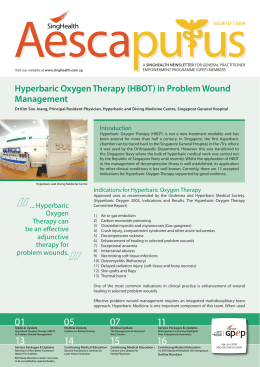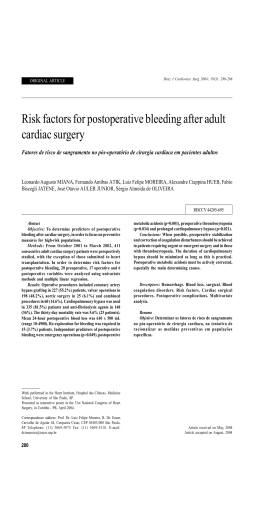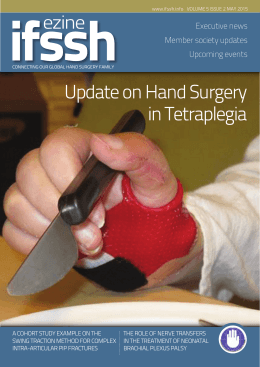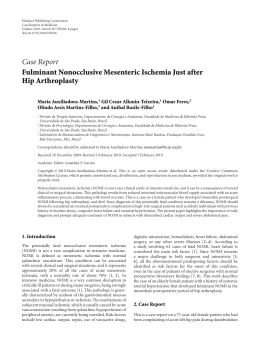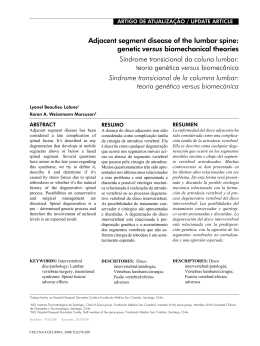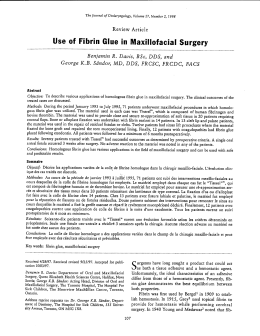artigo originaL / research report / artículo Improving the process to reduce ophthalmologic surgery cancellation and patient complaints Melhorando o processo para reduzir o cancelamento de cirurgias oftalmológicas e as queixas de pacientes Mejorando el proceso como para reducir cancelaciones de cirugías oftalmológicas y quejas de pacientes Maria Clara Padoveze* Denize Fornazari de Oliveira** Christiane Russo*** Rosaura Antonieta Azevedo de Faria*** Mariza Lino*** Maria de Lourdes Fraga Penteado**** Mirian Franzoloso Santos Martins***** Ana Paula****** Neuza Heli Zanoveli Santos****** Silvia Elaine Melo******* Keila M. Carvalho******** ABSTRACT: This study aims to describe a quality intervention program to reduce the rates of ophthalmologic surgery cancellation and patient complaints. Methods: the study was carried out at a university hospital in the state of Sao Paulo, Brazil. The intervention occurred from July to December, 2007. The methodology applied was based on the model of process improvement. A multidisciplinary work group was set up, composed of professionals from all stages in the line of surgical care and coordinated by the Quality Program staff. The goals of the project were: to reduce the rate of surgery cancellations and to reduce the number of patient complaints. An action plan was established based on the assessment of the main causes of the problems. The tools used included the worksheet 5W2H and a formal contract for the project. The rates of surgery cancellation before and after the intervention were compared using the chi square test and significance was assumed if P was less than. 05. Results: in the baseline period (2004-2005) the monthly rate of surgery cancellations ranged from 32 to 45%. In the year 2006 this rate increased from 38 to 66%. The main causes for surgery cancellations were: patient absence (33%), faults in surgical product provision (32%) and unpropitious clinical conditions (15%). Patient absence was reduced through improvement of communication between resident surgeons and the social workers team. Modifications were achieved in the provision chain for essential surgical products (intraocular lens, balanced salt solution, viscoelastic solution) and there was no more surgery cancellation caused by fault in product provision. Although there was no change in the overall rates of surgery cancellation between the baseline period (37%) and the intervention period (38%), the rates decreased compared to the year 2006 (51%) (P = 0.0001; RR: 0.75; IC: 0.71-0.78). The main cause of patient complaint was surgery cancellation; the physician-patient relationship was the object of many complaints. Specific training to improve this relationship was implemented. Patient complaints dropped from up to 20 in 2006 to about 10 per month in 2007. Conclusion: the methodology for process improvement showed to be useful in reducing the main causes of surgery cancellation and patient complaints. The work group expressed a high level of satisfaction regarding the methodology applied and the goals achieved. Keywords: Ophthalmologic surgery cancelation. Intervention program. Process improvement. Resumo: Este estudo visa descrever um programa de intervenção de qualidade para reduzir as taxas de cancelamento de cirurgias oftalmológicas e as queixas de pacientes. Métodos: o estudo foi realizado em um hospital universitário no estado de São Paulo, Brasil. A intervenção ocorreu de julho a dezembro de 2007. A metodologia aplicada se baseou no modelo de melhoria do processo. Instituiu-se um grupo de trabalho multidisciplinar composto por profissionais de todos os estágios na linha de cuidados cirúrgicos e coordenado pela equipe de funcionários do programa de qualidade. Os objetivos do projeto eram: reduzir a taxa de cancelamentos de cirurgias e o número de queixas de pacientes. Um plano de ação foi estabelecido com base na avaliação das causas principais dos problemas. As ferramentas usadas incluíram uma planilha 5W2H e um contrato formal para o projeto. As taxas de cancelamento de cirurgias antes e depois da intervenção foram comparadas usando o teste qui quadrado e a significância foi estabelecida como P menor que. 05. Resultados: no período basal (2004-2005) a taxa mensal de cancelamentos de cirurgias variou de 32 a 45%. No ano de 2006 esta taxa aumentou de 38 para 66%. As causas principais de cancelamentos da cirurgia foram: ausência do paciente (33%), falhas na provisão de produtos cirúrgicos (32%) e circunstâncias clínicas não adequadas (15%). A ausência de pacientes foi reduzida com a melhoria da comunicação entre os cirurgiões residentes e a equipe de assistentes sociais. Obtiveram-se modificações na cadeia de provisão de produtos cirúrgicos essenciais (lente intraocular, solução salina estabilizada, solução viscoelástica) e não houve mais cancelamentos de cirurgias causado por problemas de provisão de produtos. Embora não tenha havido nenhuma mudança nas taxas totais de cancelamento de cirurgias entre o período basal (37%) e o período da intervenção (38%), as taxas diminuídas se compararam às do ano de 2006 (51%) (P = 0.0001; RR: 0.75; CI: 0.71-0.78). A causa principal de queixas de pacientes era o cancelamento de cirurgias; o relacionamento médicopaciente era objeto de muitas queixas. Foi realizado um treinamento específico para melhorar esse relacionamento. As queixas de pacientes caíram de 20 em 2006 a aproximadamente 10 por mês em 2007. Conclusão: a metodologia de melhoria de processo mostrou ser útil na redução das principais causas de cancelamento de cirurgias e de queixas de pacientes. O grupo de trabalho expressou um nível elevado da satisfação quanto à metodologia aplicada e aos objetivos alcançados. Palavras-chave: Cancelamento de cirurgias oftalmológicas. Programa de intervenção. Melhoria de processo. Resumen: Resumen: Este estudio intenta describir un programa de intervención de calidad para reducir los índices de cancelación de cirugías oftalmológicas y quejas de pacientes. Métodos: el estudio fue realizado en un hospital universitario en el estado de São Paulo, el Brasil. La intervención ocurrió de julio a diciembre 2007. La metodología aplicada fue basada en el modelo de mejoría de proceso. Se estableció un grupo de trabajo multidisciplinario compuesto por profesionales de todas las etapas en la línea de cuidados quirúrgicos y coordinado por personal del Programa de Calidad. Las metas del proyecto fueran: reducir el índice de cancelaciones de cirugía y reducir el número de quejas de pacientes. Se estableció un plan de actuación basado en la evaluación de las causas principales de los problemas. Las herramientas utilizadas incluyeron el formulario 5W2H y un contrato formal para el proyecto. Los índices de cancelación de cirugías antes y después de la intervención fueran comparados utilizando la prueba chi-cuadrado, y la significancia fue considerada P menor que .05. Resultados: en el período basal (2004-2005) el índice mensual de cancelaciones de cirugías subió del 32% al 45%. El año 2006 el valor subió del 38 al 66%. Las causas principales para las cancelaciones de cirugías fueran: ausencia del paciente (el 33%), ausencia de aparatos quirúrgicos (el 32%) y condiciones clínicas non propicias (el 15%). La ausencia del paciente fue reducida con la mejora de la comunicación entre los cirujanos residentes y el equipo de asistentes sociales. Se lograran modificaciones en la cadena de productos quirúrgicos esenciales (lente intraocular, solución salina estabilizada, solución viscoelástica) y no hubo cancelación de cirugía causada por ausencia de aparatos quirúrgicos. Aunque no hubiera cambio en los índices totales de cancelación de cirugías entre el período basal (el 37%) y el período de la intervención (el 38%), los índices han disminuido en comparación al año 2006 (el 51%) (P = 0.0001; RR: 0.75; IC: 0.71-0.78). La causa principal de las quejas de pacientes era las cancelaciones de cirugías; la relación médico-paciente era causa de muchas quejas. Se ejecutó un entrenamiento específico para mejorar esta relación. Las quejas de pacientes cayeron del 20 en 2006 a cerca de 10 por mes en 2007. Conclusión: la metodología para la mejoría de proceso demostró ser útil en la reducción de las causas principales de las cancelaciones de cirugías y las quejas de pacientes. El grupo de trabajo expresó un alto grado de satisfacción respecto a la metodología aplicada y a las metas alcanzadas. Palabras llave: Cancelación de cirugías oftalmológicas. Programa de intervención. Mejoría de proceso. From the Ophthalmology Department at Faculdade de Ciências Médicas and Hospital das Clínicas, Universidade Estadual de Campinas – UNICAMP. Campinas, Sao Paulo, Brazil. * RN, PhD. Quality Program Section at Hospital das Clínicas, Universidade Estadual de Campinas, Campinas, São Paulo, Brazil and Escola de Enfermagem, Universidade de São Paulo, São Paulo, Brazil (EE-USP). E-mail: [email protected] ** MD. Ophthalmology Department.Faculdade de Ciências Médicas, Universidade Estadual de Campinas. Campinas, São Paulo, Brazil. *** RN. Operating Room Service. Hospital das Clínicas, Universidade Estadual de Campinas. Campinas, São Paulo, Brazil. **** Social Worker. Social Services. Hospital das Clínicas, Universidade Estadual de Campinas. Campinas, São Paulo, Brazil. ***** MSW. Hospital Ombudsman. Hospital das Clínicas, Universidade Estadual de Campinas. Campinas, São Paulo, Brazil. ****** RN. Ophthalmology Outpatient-care Service. Hospital das Clínicas, Universidade Estadual de Campinas. Campinas, São Paulo, Brazil. ******* Pharmacist. Operating Room Service. Hospital das Clínicas, Universidade Estadual de Campinas. Campinas, São Paulo, Brazil. ******** MD, PhD. Ophthalmology Department. Faculdade de Ciências Médicas, Universidade Estadual de Campinas. Campinas, Sao Paulo, Brazil. 82 O Mundo da Saúde, São Paulo: 2010;34(1):82-85. Improving the process to reduce ophthalmologic surgery cancellation and patient complaints Introduction Surgery cancellation is a matter of concern in many hospitals, regarding humanization, productivity and cost aspects of healthcare assistance.) A great number of reasons for cancellation can be avoided by improved planning in management, redesigning work processes, training of the staff and by carrying out early clinical evaluation¹. There is a lack in the literature regarding strategies to reduce surgery cancellation rates. In Brazil, the impact of cancelling surgeries can affect the whole public service system which has a growing demand for ophthalmologic procedures. The ophthalmology clinic at UNICAMP is a referral service for the public health system, with integrated assistance and teaching and quite a satisfactory technological infrastructure. A previous evaluation study of patient satisfaction, regarding the service provided, was rated as good by more than 90.0% of the individuals interviewed². Good results and continuous improvement of the healthcare assistance quality is a goal for the ophthalmologic team. In a previous study, ophthalmo logic surgery cancellation rat es were found to be high in our hospital 3,4. However, there was no specific intervention and the problem tends to aggravate. In the year 2006 there were many operational problems and the cancellation rates increased up to 60%. The Hospital ombudsman reported an increase in patient complaints. The present study aims to describe a quality intervention program in the ophthalmologic surgery management in order to reduce both the rate of cancellation and the number of patient complaints. Methods the study was carried out at the Hospital das Clínicas, Uni- O Mundo da Saúde, São Paulo: 2010;34(1):82-85. versidade Estadual de Campinas (HC-UNICAMP), a 400 bed public university hospital in the state of Sao Paulo, Brazil. Ophthalmologic surgeries were mainly performed in the outpatient care operating room center. The whole project was carried out from May 2007 to June 2008. The main intervention activities occurred between July and December 2007 and continued until June 2008. The period between July 2007 and June 2008 was considered as post intervention. The methodology applied was based on the model of process improvement (REF). A multidisciplinary work group was composed of professionals from all stages of the surgical care line and coordinated by the Quality Program staff. The goals of the project were to reduce to 20% the rate of surgery cancellations and to reduce the number of patient complaints to less than 6 per month. An action plan was established based on the analysis of the main causes of the problems. The tools used included the worksheet 5W2H (what, why, where, who, when, how and how much) and a formal contract for the project. This formal contract was signed by all group members and a patronage was established by one member of the board of directors of the HC-UNICAMP. The years 2004 and 2005 were considered as the baseline period. The post intervention period was considered from July 2007 to June 2008. The year 2006 was considered as the critical period. The rates of surgery cancellations before and after the intervention were compared using the chi square test and significance was assumed if P was less than .05. The Epi Info (version 6; CDC, Atlanta, Ga) was used for the analyses. Results There was an average of 3,389 ophthalmologic surgeries per year in the period between 2004 and 2007. In the baseline period (20042005) the monthly rate of surgery cancellation ranged from 32% to 45%. In the year 2006 there were many problems, and the monthly rate increased from 50% to 60%. The main causes for surgery cancellation were: patient absence (33%), faults in surgical product provision (32%) and unpropitious clinical condition (15%). The action plan involved the following activities: monthly evaluation of the indicators (surgery cancelling and patient complaints); multi-professional plan towards patient orientation for the pre, intra and post surgery phases; education project for resident physicians; and reviewing of the flow and routines for essential product supply. Patients who did not show up were contacted by telephone to find out the reasons for the absence. They were related to faults in the administrative work process (67.5%) and only 27.5% were related to personal patient problems; 5% were due to faults in the public health service system. Patient absence was reduced by improving communication between the resident surgeons and the social assistance team. After the intervention, patient absence due to failure in the administrative work process decreased to 13.6% and personal patient problems became the main reason for absence. Improvement was achieved in the provision chain for essential surgical products (intraocular lens, balanced salt solution, viscoelastic solution) and there was no more surgery cancellation due to this cause. After the intervention, unpropitious clinical condition remained to be the principal cause of surgery cancellation. 83 Improving the process to reduce ophthalmologic surgery cancellation and patient complaints During the post intervention period there was an unusual high absenteeism of operating room nurses which resulted in surgery cancellations. Due to this unexpected problem the cancellation rate failed to decrease to 20% as planned. Although there was no change in the overall rates of surgery cancellations between the baseline period (37%) and the intervention period (38%), the rates decreased compared to the year 2006 (51%) (P = 0.0001; RR: 0.75; IC: 0.71-0.78). (Table 1) The main cause of patient complaints was surgery cancellation; physician-patient relationship was part of many complaints. Specific training to improve this relationship was carried out. Patient complaints dropped from up to 20 in 2006 to about 10 per month in the post intervention period (Figure 1).The mean number of patient complaints per month was 20 in Table 1. Ophthalmologic surgeries booked, cancelled, completed and rates of cancellation in the outpatient operating room center from 2004 to June 2008 at Hospital das Clínicas, Universidade Estadual de Campinas (HC-UNICAMP) Period Surgeries booked Surgeries canceled Surgeries done Rate of cancelling (%) Baseline (2004-2005) 11,872 4,499 7,373 37.9(1) Critical (2006) 6,069 3,101 2,968 51.1(2) Post intervention (July 2007 to June 2008) 4,925 1,877 3,048 38.1(3) versus (3)p>0.80 versus (3)p<0.001 (1) (2) Figure 1. Number of patient complaints at the auditorship of the Hospital das Clínicas, Universidade Estadual de Campinas (HC-UNICAMP), regarding the Ophthalmologic Department in the year 2006 and in the post intervention period (July 2007 to June 2008) 40 35 30 25 20 15 10 84 Mar May Jan/08 Nov Sep Jul May Mar Jan/07 Sep Nov Jul Mar May 0 Jan/06 5 the year 2006 and 12 in the postintervention period. Operating room absenteeism also weakened the power of the planned intervention in this quality indicator. Discussion Cancelled operation inciden ce can vary highly according to the specialties and healthcare institution, ranging from 5.0% to 40.0%1,5,6,7,8,9,10. Ophthalmology is usually among the most affected specialties6,10. Operations can be cancelled for clinical, non-clinical, or logistic reasons. A different classification attributed to the reasons for cancelling, can be categorized by preventable or unpreventable11. The root-causes for these reasons can be quite different among healthcare institutions1,6,8,9,10. Lack of postoperative beds is the most common reason for cancelling in many establishments5,9,12. This was not a problem in the present study which focussed mainly on outpatient surgeries. The potential to prevent cancellation through good management was pointed out by others11,12,13. However, there is a lack of literature suggesting methodologies to be applied for improvement in this sector of the healthcare field. Among the reasons for cancelling, patient non-attendance has been a long time problem in our institution, as mentioned in the study of Lira et al (2001). Other studies detected patient failure in showing up as a problem1. Nevertheless, the present study demonstrated that the root-causes for the absence of patients were, in fact, caused by failures in the administrative work process, which could be dealt with through simple improvements in hospital and patient communication systems. Unfortunately, nurse absenteeism in the operating room occur- O Mundo da Saúde, São Paulo: 2010;34(1):82-85 Improving the process to reduce ophthalmologic surgery cancellation and patient complaints ring in the post intervention period could not be anticipated during the planning phase of strategy improvement. Despite this occurrence the work team was able to overcome this problem, maintaining the best management practices possible vis-à-vis the situation. The action plan succeeded in decreasing the rates of cancellation compared to the year before, but was not enough however, to reach our goals. This was probably due to unexpected events of surgery cancellation caused by the shortage of nurses. Nevertheless, considering these problems, the work group believes that without the strategies applied, the rates could have been much worse. The methodology of process improvement showed to be useful to reduce the main causes of surgery cancellation and patient complaints. Although the goals were not fully achieved, the work group expressed a high level of satisfaction and truly recognized the potential of this methodology. Further action planning is recommended to improve quality achievements in the field of surgery cancellation rates and patient complaints. REFERENCES 1. Perroca MG, Jericó MC, Facundin SD. Monitoring cancellations of surgical procedures: an indicator of organizacional performance. Rev Esc Enferm USP. 2007;41(1):113-9. 2. Oliveira DF, Arieta CEL, Temporini ER, Kara-José N. Quality of health care: patient satisfaction in a university hospital. Arq Bras Oftalmol. 2006;69(5):731-6. 3. Arieta CE, Taiar A, José NK. Use and causes of discontinuation of eye surgical interventions at a university ambulatory surgery center. Rev Assoc Med Bras. 1995;41(3):233-5. 4. Lira RP, Nascimento MA, Temporini ER, Kara-José N, Arieta CE. Reasons for cataract surgery cancellation. Rev Saúde Pública. 2001;35(5):487-9. 5. Sundaram K, Sankaran S, amorally P, Avery CME. Cancellation of elective oral and maxillofacial operations. British J Oral Maxillofacial Surgery. 2007;45:656-7. 6. Aguirre-Córdova JF, Chávez-Vázquez G, Huitrón-Aguilar GA, Cortés-Jimenéz N. Why is surgery cancelled? Causes, implications, and bibliographic antecedents. Gac Med Mex. 2003;139(6):545-6. 7. Hussain AM, Khan FA. Anaesthetic reason for cancellation of elective surgical inpatients on the day of surgery in a teaching hospital. J Pak Med Assoc. 2005;55(9):374-8. 8. Chamisa I. Why is surgery cancelled? A retrospective evaluation. S Afr J Surg. 2008;46(3):79-81. 9. Zafar A, Mufti TS, Griffin S, Ahmed S, Ansari JA. Cancelled elective general surgical operations in Ayub Teaching Hospital. J Ayub Med Coll Abbottabad. 2007;19(3):64-6. 10. Sanjay P, Dodds A, Miller E, Arumugam PJ, Woodward A. Cancelled elective operations: an observational study from a district general hospital. J Health Organ Manag. 2007;21(1):54-8. 11. Henderson BA, Naveiras M, Butler N, Hertzmark E, Ferrufino-Ponce Z. Incidence and causes of ocular surgery cancellations in an ambulatory surgical center. J Catarat Refract. 2006;32;95-102. 12. Jonnalagadda R, Walrond ER, Hariharan S, Walrond M, Prasad C. Evaluation of the reasons for cancellations and delays of surgical procedures in a developing country. Int J Clin Pract. 2005;59(6):716-20. 13. Perroca MG, Jericó MC, Facundin SD. Surgery cancelling at a teaching hospital: implications for cost management. Rev Lat Enferm. 2007;15(5):1018-24. Recebido em 10 de novembro de 2009 Aprovado em 11 de dezembro de 2009 O Mundo da Saúde, São Paulo: 2010;34(1):82-85. 85
Download








